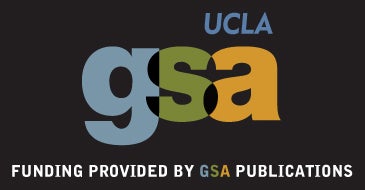66th Annual Meeting of the Society for Ethnomusicology Southern California and Hawai'i Chapter (SEMSCHC) at UCLA, March 1-2, 2025

The UCLA Ethnomusicology Department was honored to host the annual conference of the Society for Ethnomusicology Southern California and Hawai'i Chapter (SEMSCHC) on March 1-2, 2025, at UCLA. This year's conference held special significance as it marked the 70th anniversary of Mantle Hood's arrival at UCLA, a momentous occasion honoring the visionary founder of the then Institute, now Department of Ethnomusicology.

Mantle Hood demostrating rebab to UCLA Ethnomusicology students, c. 1960. Photo courtesy UCLA Ethnomusicology Archive.
The SEMSCHC Annual Conference provided a platform for undergraduate and graduate students, independent scholars, artists, and faculty from UCLA and many other institutions to present their recent work in ethnomusicology and related fields, including dance. The conference featured sessions that encouraged the exchange of ideas and promoted meaningful intellectual discussions. We were excited to welcome over 270 participants to this two-day event.
The diverse lineup included 36 engaging paper presentations, thought-provoking roundtable discussions, hands-on demonstrations, workshops, captivating daytime and nighttime concerts, and two keynote addresses. This wide variety of academic and non-academic content inspired stimulating conversations, facilitated the exchange of ideas, and highlighted potential career paths for students.
Our two keynote sessions featured Nobuko Miyamoto, icon of Asian American music and activism, and the incomparable Hazel Chung Hood (December 21, 1932 - May 13, 2025) and Made Mantle Hood, who delivered a powerful message about music, scholarship, and community, in honor of the 70th anniversary of Mantle Hood’s arrival at UCLA.

Hazel Chung Hood. Photo by Vinai Supamongkolthaveesuk.
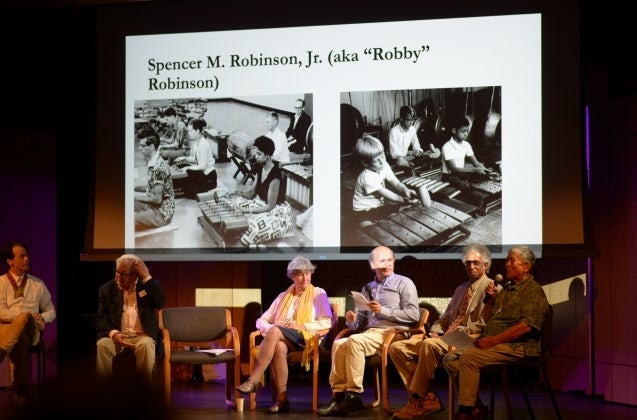
Special Roundtable. The Heritage of Ki Mantle Hood for Ethnomusicology: Reflections on the Past 70 Years. l-r: Made Mantle Hood, Robert Garfias, Bonnie Wade, Münir Beken, Spencer M. "Robby" Robinson Jr., Ric Trimillos. Photo by Vinai Supamongkolthaveesuk.
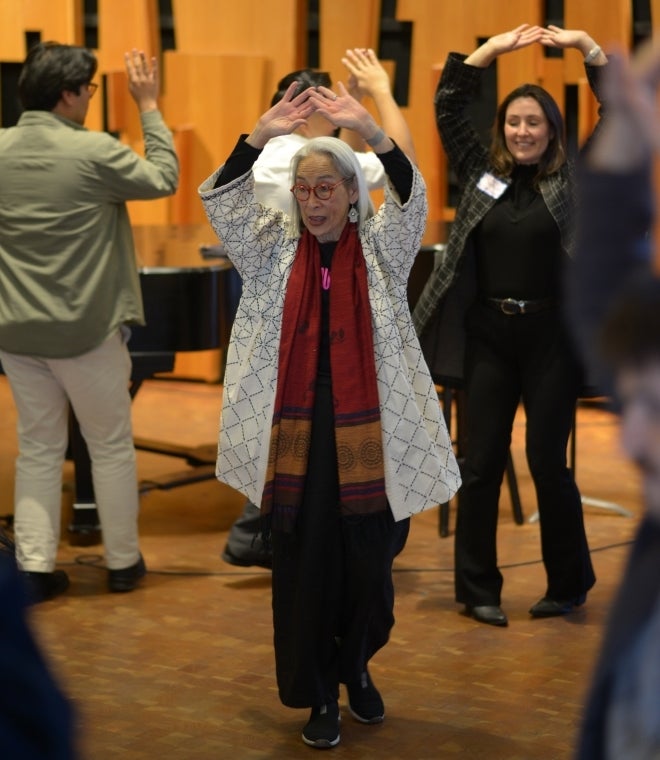
Nobuko Miyamoto leads the workshop “A Song for Ourselves.” Photo by Vinai Supamongkolthaveesuk.
To strengthen the connection between academia and the community, our two-day gathering hosted dynamic performances, comprising two evening concerts featuring seven ensembles and thirteen daytime pop-up concerts, uniting faculty, students, Los Angeles-based artists, and local community members to celebrate the vibrant diversity of music and dance. The papers in Lani Hall and the Band Room, the workshops in Ostin 110A, and live concerts at Lani Hall were recorded to ensure these powerful moments could be shared beyond the conference. With the artists' permission, the recordings will be made available online through the UCLA Ethnomusicology Archive channel on the Internet Archive, accessible to faculty, students, and community members both nationally and internationally.
“Mantle’s Memories: Embodying His Legacy in Ethnomusicology” and “The Heritage of Ki Mantle Hood for Ethnomusicology: Reflections on the Past 70 Years.”
The generous support from our co-sponsors was essential for bringing this exciting event to life. Thanks to the UCLA Ethnomusicology Archive, the UCLA Department of Ethnomusicology, the UCLA Center for Community Engagement, the UCLA Center for Southeast Asian Studies, the UCLA Ralph J. Bunche Center for African American Studies, the Mohindar Brar Sambhi Chair of Indian Music, UCLA, the Armenian Music Program at UCLA, the Gramian-Emrani Center for Iranian Music in The UCLA Herb Alpert School of Music, the Lowell Milken Center for American Jewish Music at The UCLA Herb Alpert School of Music, and The UCLA Herb Alpert School of Music.
The conference not only celebrated the 70th anniversary of Mantle Hood's arrival at UCLA and recognized his remarkable contributions to our journeys through music and dance but also allowed us to work together to inspire the next generation of musicians, scholars, and cultural advocates. And it helped us build meaningful connections and promote a deeper understanding of the rich tapestry of music and culture that unites us all.
You will find the full conference program online on the SEMSCHC website.
Attending this conference presented a unique opportunity to engage with a diverse community of scholars, students, artists, and enthusiasts who share a passion for ethnomusicology and related fields.
*****
We asked our wonderful colleague Professor Emeritus and Hompa Hongwanji Living Treasures of Hawai’i Awardee RIcardo D. Trimillos, University of Hawaiʻi at Mānoa / Ke Kulanui o Hawaiʻi ma Mānoa, to share some of his photos from the event and he kindly agreed.

Ric Trimillos, Made Mantle Hood, Hazel Chung Hood, Mitro Hood. Photo by Ric Trimillos.

Ric Trimillos with the presenters and attendees of "The Preservation, Identity, and Colonialism in Music of the Philippines" panel. Photo by Ric Trimillos.

Hauʻoli Lā Hānau / Happy birthday!! Ric Trimillos cutting his brithday cake. l-r Christopher Adler, Ric Trimillos, Bernard Ellorin, Mary Talusan Lacanlale. Photo by Supeena Adler.

So many of you asked about the cake. It is the Triple Berry Cake from Sweet Lady Jane Bakery. Photo by Supeena Adler.

Lunch from Casablanca with R. Anderson Sutton and friends. Photo by Ric Trimillos.
*****
We have asked the Ethnomusicology students and faculty who attended the conference to share their thoughts. So, without further ado...
*****
From Professor Melissa Bilal, The Promise Chair in Armenian Music, Arts, and Culture, Director of the Armenian Music Program
As the UCLA Armenian Music Program, we were thrilled to perform in this historic meeting of SEMSCHC at UCLA. The pop-up concert by Lori Der Sahakian (Ethnomusicology PhD student and AMP voice fellow), Mickey Hashim (Mathematics and Ethnomusicology undergraduate student and AMP shvi fellow), Sona Nalbandian (Ethnomusicology undergraduate student and AMP kamancha fellow), and Hasmik Harutyunyan (AMP folk singing mentor) showcased our program's efforts for an in-depth study of Armenian folk music repertoires, their history, and their meaning, and our mission to share those to broaden the community of its practitioners and listeners. We would like to thank the organizers for giving us the opportunity.

l-r: Hasmik Harutyunyan, Sona Nalbandian, Mickey Hashim, Lori Der Sahakian. Photo by Melissa Bilal.
*****
From graduate student in Ethnomusicology at UCLA Yaron Cherniak
I lived in Jerusalem for eight years, followed by another four in its suburbs. During these years, I recall hearing only once about a group referred to as gypsies who were living within the surrounding walls of Jerusalem’s Old City. Though I never had the chance to meet them, my curiosity grew. I wanted to learn about their origins, their culture, and musical heritage. That have led me to conduct ethnographic research on one of the least known communities in Israel, the Dom, a collective of several nomadic groups believed to have migrated from India in the twelfth century to the Middle East.
This research would not be possible to complete without financial support. The GSRM grant I received in my first year as a UCLA PhD student, and a stipend from the UCLA Nazarian Center for Israel Studies, funded my work supporting the Dom community and researching their musical heritage. I'm extremely grateful to my wonderful advisor, Mark Kligman, for his guidance throughout this research project, and to Anna Morcom for her help with my successful GSRM grant application. Their support, as well as our department faculty and their inspiring and rigorous guidance, provided me with a great source of support and comfort during my July and August 2024 fieldwork in Israel.
Attending the SEMSCHC 2025 conference to present a paper was a significant event. We enjoyed two full days of diverse themes presented by well-known speakers and colleagues from UCLA and other universities. The vibrant and diverse program, possibly the only regional ethnomusicology conference of its kind, was largely due to the inspiration and significant contributions of many faculty members, including Supeena Adler, Maureen Russel, Donna Armstrong, Paul Bancel, and Kathleen Hood. It offered a truly immersive, multicultural musical experience. A wide array of musical traditions—Persian, Ghanaian, Mariachi, Balinese, Thai, Hindustani, Klezmer, and more—along with other groups and solo artists (myself included), filled the conference with music from across the globe - a true Bruin pride, and our ethnomusicology department true bi-musicality spirit.

Yaron Cherniak, “Reclaiming Identity Through Song: Preservation, Adaptation, and Agency in the Dom Communities of Jerusalem and Beyond.” Photo by Vinai Supamongkolthaveesuk.
Presenting my essay “Reclaiming Identity Through Song” as part of the Musical Transmission Amidst Geopolitical Change panel was a significant experience. The success was partly due to the strong teamwork of my fellow panelists, Courtney Blue and Mikey M. Aboutboul, who collaborated effectively to deliver impactful and enriching presentations. It was also an opportunity for me to share some of my additional work with the Dom community in Jerusalem. Going out of my research project scope, I was producing a cultural event open for the public in Israel, inviting and celebrating the Jerusalem Dom community in the Old City. I incorporated traditional Dom music, creating a stronger network of individuals and institutions to support the Dom community financially. This event also served as a platform for the Domari Center’s director, Amoun Sleem, and other Doms to voice their needs and aspirations as a minority group in Israel. We invited guest speakers to lecture on the Dom community's history, and gathered more than $8000 to support the Domari center by funding traditional music instruments, music lessons for the Domari center, designing T-shirts, postcards depicting Doms’ nomadic lifestyle to sell as merchandize, and full-size photo prints of Jerusalem Doms from 1910 which we presented in a gallery on the day of the event. All efforts aim to provide financial support and generate public interest by raising awareness of the Jerusalem Dom community as an act of cultural ratification.
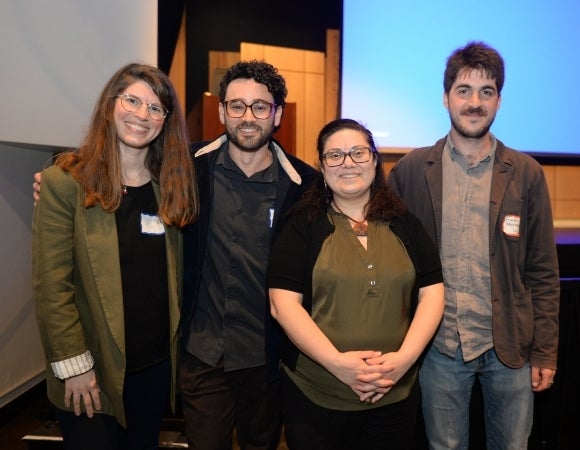
"Musical Transmission Amidst Geopolitical Change" Panel. l-r: Courtney Blue, Yaron Y. Cherniak, Melissa Bilal (Chair), Mikey M. Aboutboul. Photo from author.
I'm deeply grateful to everyone who came to and supported this conference; its impact extends far beyond academia.

Uşşak: Music from Turkey and Iran, Michael Aboutboul and Yaron Cherniak. Photo by Maureen Russell.
*****
From graduate student in Ethnomusicology at UCLA Juan Del Real
The Presence of Korean Music at the 66th Annual Meeting of the Society for Ethnomusicology Southern California and Hawai'i Chapter (SEMSCHC).
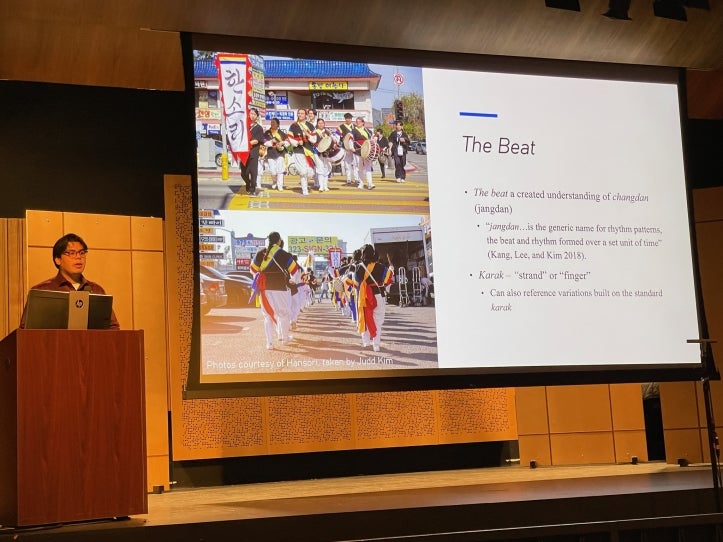
Juan Manuel Del Real (UCLA), “Jishinbalpki and the Sounds of Drumming through the Streets of Los Angeles’ Koreatown.” Photo by Helen Rees.
Traditional Korean music first arrived at the then Institute of Ethnomusicology at the University of California, Los Angeles, in the 1960s, making it possible to hear its sounds for the first time. Today, around 60 years later, traditional Korean music (and now South Korean pop music) continues to have a place in the Department of Ethnomusicology. A truth extended to the 2025 SEMSCHC conference held at UCLA, which marked the seventieth year since Mantel Hood arrived at UCLA. The panel titled “Explorations in Cross-Cultural Korean Music” was held on Sunday, March 2nd, and three diverse presentations were given by three scholars. The first was presented by myself, where I shared the narrative of two collegiate drumming groups and their service to their community at the annual Jishinbalpki held in Koreatown, Los Angeles. Next was Kie Zuraw, who presented her work completed with Suzy Ahn that explored questions related to text-setting in contemporary K-pop. Finally, Gamin Kang presented her findings on American composer Lou Harrison’s works that had been inspired by traditional Korean music, especially by the p’iri. Each presentation is representative of various points of discussion in current Korean Music Studies, and I feel honored to have been able to share the panel with these scholars. At the panel’s conclusion, Kang and I quickly made our way outside as we prepared for our performance of a traditional Korean folk song medley. Kang performed on the p’iri and I, on the changgu. It was quite windy and a bit cold, yet we went on weaving through melodies and cycling through various changdans. The sounds of traditional Korean music were a fitting end to our presentations and marked a lovely start to Sunday’s lunch break. These presentations and the performance represent the diverse musical landscape present at the conference and the current presence of traditional and contemporary Korean music currently found at UCLA.
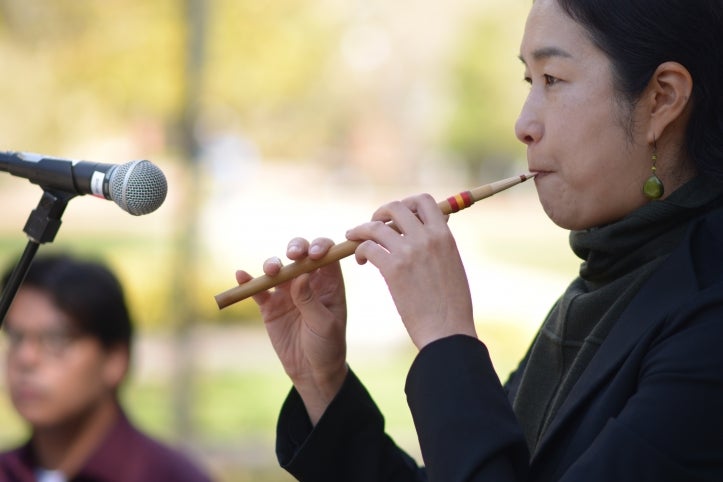
Juan Del Real and Gamin Kang. Photo by Vinai Supamongkolthaveesuk.
*****
From graduate student in Ethnomusicology at UCLA Rane Prak
I attended day two of the 66th Annual Meeting of the Society for Ethnomusicology Southern California and Hawai'i Chapter at the University of California, Los Angeles, CA. This year's conference was one of the largest and is an opportunity for attendees to connect with scholars from other universities and also learn from their peers in the field. Reflecting upon this experience, I realized that Dr. Supeena Adler and Dr. Russell did an incredible job of bringing the community together through two types of events: research and performance. This conference reflects the tradition of Dr. Mantle Hood's bi-musicality.
I truly realized the immense volunteer experience the labor, time, and teamwork necessary to organize and run a conference smoothly. A couple of other Graduate Student Researchers (GSRs) and I from UCLA's Department of Ethnomusicology volunteered to assist with registration, setting up tables, and performances. The walk to campus was a workout since I was carrying my heavy MacBook, hair supplies, makeup, a klui (Thai flute), and even a pair of silver sandals to change into. I arrived for my volunteer shift at 7:30 am. Dr. Adler, part of the organizing committee, asked me to move the Thai instruments from the Isaan (northeastern) region from the Evelyn & Mo Ostin Music Center back to the Music of Thailand ensemble room. I then transported the remaining instruments from Evelyn & Mo Ostin Music Center, which consisted of phin (Thai lute), khaen (Thai mouth organ), and wot (Thai pan pipe). My next volunteer task was to help Dr. Kathleen Hood in transporting the drum set to backstage of Schoenberg Hall.
After completing my morning volunteer tasks, I switched hats to be an attendee. The first paper panel I attended was Identity and Colonial Violence in EDM and Techno Location: 1345 Schoenberg Music Building (Band Room). From Aydin Quach's paper “Orienting Towards Techno-Asiatics: The Place of Affect in Asian North American Consumption of Electronic Dance Music,” I learned that Asiatics means recognized as Asian but not necessarily associated with Asia. Son Goku is a Japanese anime character used in various contexts in different countries, from techno dance to activism events. Activism was one theme that I saw in this paper panel and the next event I attended. I was healed through listening to the beautiful and uplifting music by Florecer Collective who performed protest music of Latin America, organized by UCLA Ethnomusicology PhD student and my dear friend Learsi.

Florecer Collective:Protest Music of Latin America. Organized by Learsi Martinez. l-r:Jillian Risigari-Gai Lopez, Learsi Martinez, Gabriela Acosta, John Hollywood, Emma Young, Sienna Ruiz. Photo by Vinai Supamongkolthaveesuk.
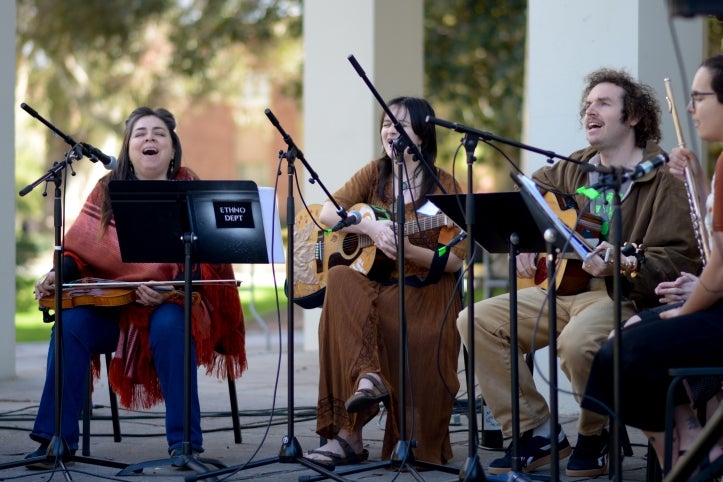
Florecer Collective:Protest Music of Latin America. Organized by Learsi Martinez. Photo by Vinai Supamongkolthaveesuk.
After Florecer's performance, I attended another friend of mine, UCLA Ethnomusicology PhD student Juan's paper presentation on “Jishinbalpki and the Sounds of Drumming through the Streets of Los Angeles’ Koreatown.” Juan's presentation illuminates the rich Korean American performing arts of drumming in Los Angeles and how students continue this tradition and connect with the diasporic community in Korea Town. The paper I attended next was also given by UCLA Ethnomusicology PhD student Tingting Tang “TikTok (Douyin) Effects on Soundscape Composition of Naxi Intangible Cultural Heritage in Practice: A Case Study in Eya Big Village.” From this paper, I learned that the Naxi are live streaming their culture on TikTok. I also see this reflected in my fieldwork with Cambodian American performing arts. One of my dance teachers also livestreams our rehearsals and performances on Facebook. I am no longer the exclusive filmmaker during my fieldwork. After Tingting's paper, I volunteered to serve lunch from Simpang Asia Indonesian Food. My favorite dish was the stir-fried noodles.

Juan Manuel Del Real (UCLA), “Jishinbalpki and the Sounds of Drumming through the Streets of Los Angeles’ Koreatown.” Photo by Vinai Supamongkolthaveesuk.

Tingting Tang (UCLA), “TikTok (Douyin) Effects on Soundscape Composition of Naxi Intangible Cultural Heritage in Practice: A Case Study in Eya Big Village.” Photo by Vinai Supamongkolthaveesuk.
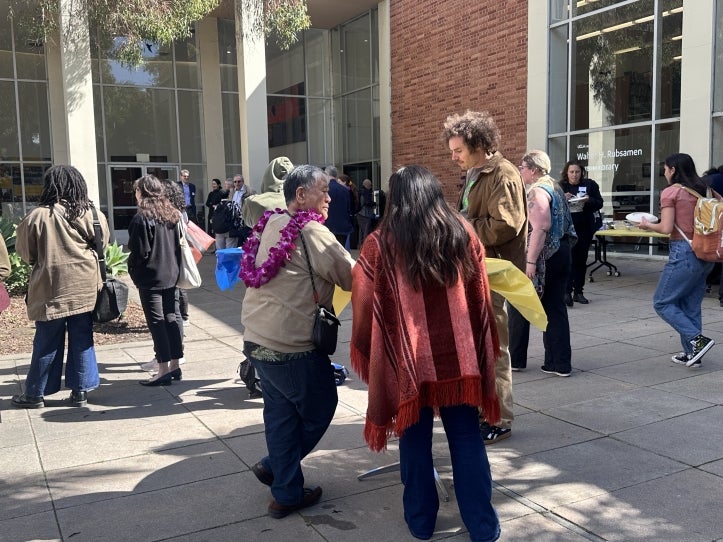
Sunday lunch, catered by Simpang Asia, at SEMSCHC 2025. Photo byTIngting Tang.
After lunch, I attended the Kulintang Music and Dance (organized by Ube Arte), where I learned the Filipino dance Balangay. I see similarities between Balangay and Cambodian dance because of its groundedness and association with nature.
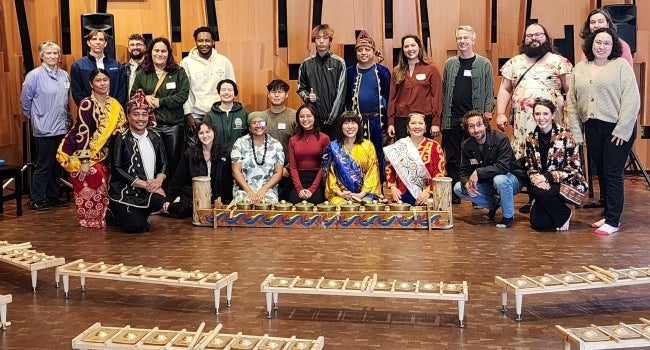
Kulintang Music and Dance Workshop led by Ube Arte. Photo by Maureen Russell.
After the Business Meeting, I got ready to perform for the evening concert with the Music of Thailand Ensemble, directed by Dr. Supeena Insee Adler.

Rane Prak dancing, Music of Thailand, Supeena Insee Adler, Director. Photo by Vinai Supamongkolthaveesuk.
*****
From Tingting Tang, UCLA Ethnomusicology PhD Candidate
On 1-2 March 2025, the UCLA Department of Ethnomusicology hosted the 66th Annual Meeting of the Society for Ethnomusicology Southern California and Hawai’i Chapter (SEMSCHC). As both a presenter and a GSR for the Ethnomusicology Archive, I had the privilege of engaging with this dynamic and intellectually stimulating conference.
Figure 1. The Heritage of Ki Mantle Hood for Ethnomusicology: Reflections on the Past 70 Years, Lani Hall, Schoenberg Music Building, March 1, 2025. Presenter: Made Mantle Hood (Tainan National University of the Arts). Photo by author.
The UCLA Department of Ethnomusicology holds a foundational place in the field, deeply rooted in the pioneering work of Mantle Hood, who established the first graduate program in ethnomusicology in the United States. Hood’s emphasis on embodiment and bi-musicality revolutionized the discipline, shaping generations of scholars and performers. This legacy continues to thrive at UCLA, where the department remains a global leader in research, performance, and archival preservation. At the 66th SEMSCHC conference, we honored this heritage with the panel The Legacy of Ki Mantle Hood for Ethnomusicology: Reflections on the Past 70 Years (see Figure 1), featuring Hazel Chung Hood, Made Mantle Hood, Jacqueline Cogdell DjeDje, Robert Garfias, Bonnie Wade, Münir Beken, and Spencer M. Robinson, Jr (see Figure 2).
Figure 2. The Heritage of Ki Mantle Hood for Ethnomusicology: Reflections on the Past 70 Years, Lani Hall, Schoenberg Music Building, March 1, 2025. Roundtable panelists (left to right): from left to right, Robert Garfias (University of California, Irvine), Bonnie Wade (UC Berkeley), Münir Beken (UCLA), Spencer M. Robinson, Jr. (Son of Gertrude Rivers Robinson), and Ric Trimillos (University of Hawai‘i at Mānoa). Photo by author.
In keeping with Hood’s legacy, the UCLA conference organizing committee invited Nobuko Miyamoto—a pioneering artist whose work bridges music, activism, and community engagement—to lead a workshop titled A Song for Ourselves. The schedule runs from 4:00-5:30 pm, on 2 March, with Miyamoto’s presentation, performance, and singing and dancing sessions for everyone.
The presentation session opened with a meditative moment as Miyamoto rang a singing bowl and used her voice to set a reflective tone (see Figure 3). She then shared her personal journey as a Japanese American artist, recounting her early career as a dancer and Broadway performer and how her political awakening during the civil rights and anti-war movements of the 1960s led her to songwriting. Through her activism, she recognized the need for music that reflected Asian American experiences, a realization that culminated in her collaboration with Chris Iijima and Charlie Chin on A Grain of Sand (1973)—a groundbreaking album that gave voice to Asian American struggles and identity. For Miyamoto, songwriting became a powerful tool for expressing resilience, solidarity, and social change.
Figure 3. Featured Presentation/Workshop: Nobuko Miyamoto – “A Song for Ourselves,” Ostin 110A, March 2, 2025. Photo by author.
After sharing how she explored and reclaimed Japanese musical traditions within the context of American culture—boldly weaving them into her own music and dance—as a bonus, Miyamoto invited us to participate in a circle dance she created (see Figure 4). This dance, embraced by many Japanese temples across the United States, symbolizes the diverse and layered spiritual world carried by many Asian Americans. Through movement and music, the workshop embodied the fusion of tradition and innovation that defines Miyamoto’s artistic and activist legacy.
Figure 4. Featured Presentation/Workshop: Nobuko Miyamoto – “A Song for Ourselves,” Ostin 110A, March 2, 2025. Photo by author.
Immersed in Miyamoto’s wonderful stories and music, I couldn’t help but want to catch these beautiful and moving moments with my cell phone. Her humble, amiable personality and creative music and dance have sent great energy to my heart. For me, Miyamoto is not only a famous artist but also a pioneering practitioner of applied ethnomusicology. For decades, she has used her work to give voice to people from minority groups, to provide more Asian Americans with a “moment of urgency” and a public space in which all can feel and participate. At the end of the workshop, she encouraged all of us to feel positively about our environment, our bodies, and the most enjoyable life dynamics.
The fast-paced, action-packed two-day conference was filled with countless insightful and memorable moments. The diverse and inspiring forums led by scholars and doctoral students from universities across the U.S., along with conversations with renowned ethnomusicologists, reinvigorated my passion for research and broadened my perspective. Above all, the experience made me especially proud to be part of our ethnomusicology department at UCLA.
*****
From Wan Yeung, PhD in Ethnomusicology, 2024, UCLA
The 66th Annual Meeting of SEMSCHC at UCLA served as a vibrant nexus where shared passion, dynamic performances, and critical scholarly exchange converged to enrich our understanding of ethnomusicology. I presented my paper, “Echoes Across Diaspora: The Circulation of Cantonese Opera LPs and Cultural Identity in the Mid-20th-Century Americas,” which was born out of months of dedication, after painstakingly sorting through over two thousand envelopes in the Golden Star Collection housed at the UCLA Ethnomusicology Archive. Sharing the intricate process of coding and analyzing these archival materials has been immensely rewarding. I also had the pleasure of connecting with Charles Sharp, who acquired the collection with Helen Rees in San Francisco two decades ago. It was a privilege to share with them how their work has enabled a deeper exploration of how Cantonese opera records served as cultural anchors for Cantonese communities in postwar America.
Author presenting “Echoes Across Diaspora.” Photograph by Tingting Tang.
The featured roundtable was particularly inspiring. Made Mantle Hood’s discussion on bimusicality offered fresh insights into one of the field’s foundational concepts, while Hazel Chung Hood shared captivating stories of her early years at UCLA that shed light on the formative period of UCLA Ethnomusicology. Equally enriching were the reflections of Robert Garfias, Bonnie Wade, Münir Beken, and Spencer M. Robinson Jr., whose accounts deepened my appreciation of UCLA Ethnomusicology’s enduring legacy. Their narratives breathed new life into many photographs and documents I had encountered as a graduate student researcher at the Ethnomusicology Archive.
Made Mantle Hood and Hazel Chung Hood receiving standing ovation. Photograph by author.
A highlight of the conference was the rich variety of musical performances at the Schoenberg Music Building Patio during breaks and lunch periods. These sessions buzzed with energy, offering attendees an immersive experience in diverse musical traditions from around the world. Another notable moment of the conference was Nobuko Miyamoto’s presentation and workshop, “A Song for Ourselves.” In her session, Miyamoto not only showcased innovative approaches to community music-making but also illuminated how her work was deeply rooted in activism. The workshop underscored the transformative power of music, reminding us that artistic expression can be a potent vehicle for social change and collective empowerment.
Masanobu Kinjo (director), Supeena Insee Adler, and Christopher Adler performing Okinawa folk songs. Photograph by author.
Nobuko Miyamoto leading participants in a dance during her workshop. Photograph by Tingting Tang.
The SEMSCHC conference was a powerful reminder of UCLA Department of Ethnomusicology’s lasting impact on the field. Reconnecting with familiar faces and engaging in meaningful discussions with esteemed scholars such as Robert Garfias, David Novak, and Scott Spencer reinvigorated my research ambitions. This experience has left me both rejuvenated and inspired, eager to contribute to a vibrant academic community that thrives on connection, shared insight, and the transformative power of music.
*****
From Guangming Li, PhD in Ethnomusicology, 2001, UCLA
I had a wonderful experience participating in the 2025 SEMSCHC conference, held March 1–2. I'm especially grateful to the conference committee for the opportunity to share my research on postophony, a broadly applicable type of musical texture I identified while teaching a course on Chinese instrumental music at UCLA.
I was heartened by the thoughtful interest my presentation received, particularly from students and colleagues in ethnomusicology and music education. It was both rewarding and inspiring to see the concept resonate across disciplinary lines and spark meaningful conversation.
Having not attended an SEM meeting in some time, I was reminded of the vibrant sense of community that defines these gatherings—where classmates, colleagues, friends, mentors, and distinguished scholars come together. Though I was only able to attend part of the event, the atmosphere was uplifting, the participants were engaged and enthusiastic, and the hospitality provided by the service crew made it feel more like a warm reunion than a formal academic conference.
It was also a special privilege to participate in this year’s conference, which marked the 70th anniversary of Mantle Hood’s arrival at UCLA. I hold the profound admiration for Dr. Hood—his scholarship, visionary leadership, and pioneering concept of bi-musicality have profoundly shaped the field. I still vividly remember attending his lecture as a student at the Central Conservatory of Music in Beijing. That moment sparked my dream of studying at UCLA—a dream I’m grateful to have realized.
While we may not always recall the exact words or moments, we often remember how an experience made us feel. Attending this conference was both memorable and deeply meaningful—one that will stay with me.
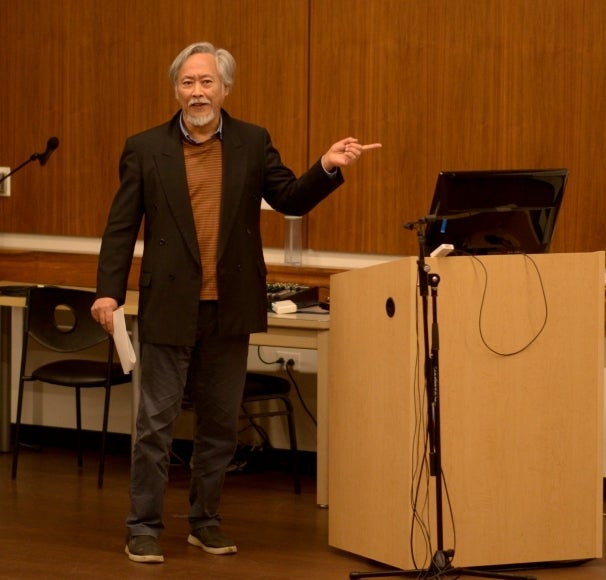
Guangming Li presenting “Beyond the Tetrad: “Postophony” as a New Textural Category.” Photo by Vinai Supamongkolthaveesuk.
*****
66th Annual Meeting of the Society for Ethnomusicology Southern California and Hawai‘i Chapter. Saturday Evening Concert at Lani Hall, Schoenberg Music Building, UCLA.
66th Annual Meeting of the Society for Ethnomusicology Southern California and Hawai‘i Chapter. Sunday Evening Concert at Lani Hall, Schoenberg Music Building, UCLA.



